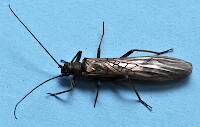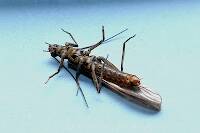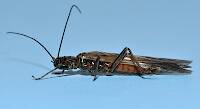
Salmonflies
Pteronarcys californica
The giant Salmonflies of the Western mountains are legendary for their proclivity to elicit consistent dry-fly action and ferocious strikes.
Featured on the forum

This specimen appears to be of the same species as this one collected in the same spot two months earlier. The identification of both is tentative. This one suffered some physical damage before being photographed, too, so the colors aren't totally natural. I was mostly photographing it to test out some new camera setting idea, which worked really well for a couple of closeups.

Troutnut is a project started in 2003 by salmonid ecologist Jason "Troutnut" Neuswanger to help anglers and
fly tyers unabashedly embrace the entomological side of the sport. Learn more about Troutnut or
support the project for an enhanced experience here.
Entoman on Mar 1, 2012March 1st, 2012, 5:23 pm EST
Regarding the small dark stoneflies of Winter & early Spring, we all hear these common names thrown about a lot:
Little Winter Black Stone
Little Winter Brown Stone
Tiny Black Snowfly
Tiny Brown Snowfly
Little Black Needlefly
Little Brown Needlefly
Early Brown Stone
Early Black Stone
Eastern Willowfly
These are the families and their important genera that are associated with the common names above:
Capniidae (Capnia and Allocapnia)
Leuctridae (Leuctra)
Nemouridae (Nemoura and Zapada)
Taeniopterygidae (Doddsia, Strophopteryx, Taenionema and Taeniopteryx)
Which go with which?
Here's a fly in the ointment though.:) These two photos are of the same species, Strophopteryx fasciata:
http://www.troutnut.com/im_regspec/picture_1082_large.jpg
http://www.pbase.com/tmurray74/image/111459174
I figured this would be a good topic to chew on this time of year.
Little Winter Black Stone
Little Winter Brown Stone
Tiny Black Snowfly
Tiny Brown Snowfly
Little Black Needlefly
Little Brown Needlefly
Early Brown Stone
Early Black Stone
Eastern Willowfly
These are the families and their important genera that are associated with the common names above:
Capniidae (Capnia and Allocapnia)
Leuctridae (Leuctra)
Nemouridae (Nemoura and Zapada)
Taeniopterygidae (Doddsia, Strophopteryx, Taenionema and Taeniopteryx)
Which go with which?
Here's a fly in the ointment though.:) These two photos are of the same species, Strophopteryx fasciata:
http://www.troutnut.com/im_regspec/picture_1082_large.jpg
http://www.pbase.com/tmurray74/image/111459174
I figured this would be a good topic to chew on this time of year.
"It's not that I find fishing so important, it's just that I find all other endeavors of Man equally unimportant... And not nearly as much fun!" Robert Traver, Anatomy of a Fisherman
Wiflyfisher on Mar 1, 2012March 1st, 2012, 5:40 pm EST
I agree there is a lot of confusion about these little guys all over the web. Common names make things very confusing at times. Everytime I hear someone talk about early season stoneflies I always wonder what are they really referring too.
The only one I focus on is a size #14-#12 brownish wing and blackish body. I have never tried to properly ID them but have always referred to them as "Early Brown Stonefly". Jason has photos from the same river at the same time period March/April as I do.
The tiny size #18s that look all black (body & wing) I never bothered with because I have never come across a really decent hatch.
The only one I focus on is a size #14-#12 brownish wing and blackish body. I have never tried to properly ID them but have always referred to them as "Early Brown Stonefly". Jason has photos from the same river at the same time period March/April as I do.
The tiny size #18s that look all black (body & wing) I never bothered with because I have never come across a really decent hatch.
John S.
https://WiFlyFisher.com
https://WiFlyFisher.com
Entoman on Mar 1, 2012March 1st, 2012, 6:24 pm EST
Hi John,
Yes, there sure is.
I noticed that. That's the species I chose to link. Jason's is black bodied with a smoky wing. Though you can't see it through the tannish brown wing, the other one has a body that is a rich brown. Check out this photo of Crepuscular's: http://www.troutnut.com/im_user_ident/picture_270_large.jpg
It's the same species as well. It sounds like your bug (as you describe it) seems to split the difference?
That's one of the reasons I started this thread. I used to think that as well. I'm not so sure anymore...
I agree there is a lot of confusion about these little guys all over the web.
Yes, there sure is.
Jason has photos from the same river at the same time period March/April as I do.
I noticed that. That's the species I chose to link. Jason's is black bodied with a smoky wing. Though you can't see it through the tannish brown wing, the other one has a body that is a rich brown. Check out this photo of Crepuscular's: http://www.troutnut.com/im_user_ident/picture_270_large.jpg
It's the same species as well. It sounds like your bug (as you describe it) seems to split the difference?
Common names make things very confusing at times.
That's one of the reasons I started this thread. I used to think that as well. I'm not so sure anymore...
"It's not that I find fishing so important, it's just that I find all other endeavors of Man equally unimportant... And not nearly as much fun!" Robert Traver, Anatomy of a Fisherman
Crepuscular on Mar 2, 2012March 2nd, 2012, 6:43 am EST
I collected some yesterday I will try and get some photos posted today just to make things a little more confusing!
Falsifly on Mar 2, 2012March 2nd, 2012, 9:24 am EST
I hope I’m not adding to the confusion, I’d like to think I’m clearing up a misnomer. As stated on another thread I’ve only experienced this tiny, little, early, winter, brown, black, whatever it is, stonefly, once many years ago. I’ve noted reference to fishing the hatch, but I can assure you that what I experienced was not a hatch. Correct me if I’m wrong but it is ovipositing in mass.
Falsifly
When asked what I just caught that monster on I showed him. He put on his magnifiers and said, "I can't believe they can see that."
When asked what I just caught that monster on I showed him. He put on his magnifiers and said, "I can't believe they can see that."
Entoman on Mar 2, 2012March 2nd, 2012, 10:50 am EST
Question: If we all abandoned the use of common names and for this example used only the name Strophopteryx fasciata, would confusion regarding what's important to anglers be lessened?
"It's not that I find fishing so important, it's just that I find all other endeavors of Man equally unimportant... And not nearly as much fun!" Robert Traver, Anatomy of a Fisherman
Falsifly on Mar 2, 2012March 2nd, 2012, 11:51 am EST
Question: If we all abandoned the use of common names and for this example used only the name Strophopteryx fasciata, would confusion regarding what's important to anglers be lessened?
“What's important to anglers” is the key to the answer. Personally I have never really concerned myself with scientific nomenclature, however when discussion turns to specifics we are left with little choice. You either educate yourself to the point were you can discuss the issue or bow out and watch from the sidelines. I think it’s more of a question of an individual’s level of interest. It behooves us as fly fishermen to at least have a cursory knowledge in aquatic entomology but do we all think we need to be able to identify to a species level? I think not. But this stonefly discussion has my interest up, as does “Subimago to identify”. I feel that using the name Strophopteryx fasciata clears up a lot of confusion. The only confusion I am left with is whether or not I’m pronouncing it right.
Falsifly
When asked what I just caught that monster on I showed him. He put on his magnifiers and said, "I can't believe they can see that."
When asked what I just caught that monster on I showed him. He put on his magnifiers and said, "I can't believe they can see that."
Wiflyfisher on Mar 2, 2012March 2nd, 2012, 12:48 pm EST
I’ve noted reference to fishing the hatch, but I can assure you that what I experienced was not a hatch. Correct me if I’m wrong but it is ovipositing in mass.
That is exactly what I have witnessed, ovipositing in mass.
I think it’s more of a question of an individual’s level of interest. It behooves us as fly fishermen to at least have a cursory knowledge in aquatic entomology but do we all think we need to be able to identify to a species level? I think not.
Totally agree. My personal interest has always been to be able to know enough so I understand the insect's characteristics, habitat and life cycle, along with how the trout behave towards that insect during it's various stages. All of this is so I can apply that to my fly tying and fly fishing to hopefully make me more successful.
I am also careful before taking someone's word as to what they scientifically identify an insect as, especially on the Internet. Unless, I feel they really know their aquatic entomology. Troutnut.com tends to offer more creditability than other FF forums do because some of you enjoy getting right down to examining everything including the gonads. :-)
My reference to common names was in general, not just targeted at the early stoneflies. I find common names often are misused so I take a cautious approach until I can see the insect myself, or get some feedback from someone I trust through their experiences.
As examples: I can remember years ago in early May some guy yelling at 9:30 am on the East Branch of the Delaware "The Tricos are hatching!". I had no idea what the small critter was but it was definitely not Tricos, nor was it important to the trout feeding that day.
More recently on the head of Quake Lake two guys told me that the Green Drakes were starting to hatch and the bug they showed me was clearly what I would call Ephemera simulans (Brown Drake). So I fished the hatch like I would for Brown Drakes and had a wonderful evening.
That's my $0.02, and I do not judge others on how they like to view it. Each to their own, I just hope they enjoy the sport in their own way.
Now I have to go out and shovel some white stuff. :(
John S.
https://WiFlyFisher.com
https://WiFlyFisher.com
Entoman on Mar 2, 2012March 2nd, 2012, 6:44 pm EST
Al -
I don't know, Al. I'm still pondering this. I think the hope this is true leads us to think so, but consider this - what if somebody posted a fishing report for a new place we've never been before and it read as follows, "A fall of Strophopteryx fasciata occurs in the afternoon." What would we expect it to look like? Conversely, what if it read, "A fall of Tiny Black Snowflies occurs in the afternoon."?
Man, is that the truth.:) I learned most of the important insect names in my youth from reading. Having never heard them pronounced before, I made up my own. When I finally learned the right way (if there is such a thing), the ones I made up were so firmly ingrained that I still pronounce Epeorus (EE-PEE-OR'-UUS) as EP'-OR-US if I'm not thinking about it.:) As to Strophopteryx fasciata I believe it is pronounced (as in throw) STROW-FOWP-TEAR'-IX (as in six) and (as in fast) FA-SKI-ATE'-AH. Oh geez, I hope this doesn't lead to a string of off-topic Latin tomato/tomahto comments!:)
John -
I couldn't agree more. One of the things that drew me to this site was all the free exchange of ideas and desire to work at a determination. One of the things that bugs me about most sites is there is often only one or two quick comments without explanation (and they're often wrong) - sometimes with an insult offered. I remember one that really made me chuckle. Perhaps they were the guys you met at Quake Lake? There was a request for for an ID of a specimen of Ephemera simulans. The first reply came back, "That is an Isonychia." The second read, "I agree." The third and last one read, "You guys need to learn your mayflies before commenting on the forum. This is a March Brown". What can you do with that?:)LOL
It's done much better here. A beautiful example is the recent hex thread Al mentioned that a bunch of us jumped on like big trout going after Cheez-Its at Fanny Bridge. Personally, I get much more out of somebody's opinion when they explain there reasoning. It makes for long threads sometimes (usually with a few detours), but in the end I think we all go away with a much better understanding of the critter at hand. I think it's pretty rare that one gets through the gauntlet attached to a consensus error. Of course, a lot of them end up without a consensus agreement too!:) The reality is taking photos to the specific level is little better than speculation for many genera anyway.
:):) Yeah, error is error whether scientific or common language is used. That's a pretty big one though!:)
I feel that using the name Strophopteryx fasciata clears up a lot of confusion.
I don't know, Al. I'm still pondering this. I think the hope this is true leads us to think so, but consider this - what if somebody posted a fishing report for a new place we've never been before and it read as follows, "A fall of Strophopteryx fasciata occurs in the afternoon." What would we expect it to look like? Conversely, what if it read, "A fall of Tiny Black Snowflies occurs in the afternoon."?
The only confusion I am left with is whether or not I’m pronouncing it right.
Man, is that the truth.:) I learned most of the important insect names in my youth from reading. Having never heard them pronounced before, I made up my own. When I finally learned the right way (if there is such a thing), the ones I made up were so firmly ingrained that I still pronounce Epeorus (EE-PEE-OR'-UUS) as EP'-OR-US if I'm not thinking about it.:) As to Strophopteryx fasciata I believe it is pronounced (as in throw) STROW-FOWP-TEAR'-IX (as in six) and (as in fast) FA-SKI-ATE'-AH. Oh geez, I hope this doesn't lead to a string of off-topic Latin tomato/tomahto comments!:)
John -
I am also careful before taking someone's word as to what they scientifically identify an insect as, especially on the Internet. Unless, I feel they really know their aquatic entomology. Troutnut.com tends to offer more creditability than other FF forums do because some of you enjoy getting right down to examining everything including the gonads. :-)
I couldn't agree more. One of the things that drew me to this site was all the free exchange of ideas and desire to work at a determination. One of the things that bugs me about most sites is there is often only one or two quick comments without explanation (and they're often wrong) - sometimes with an insult offered. I remember one that really made me chuckle. Perhaps they were the guys you met at Quake Lake? There was a request for for an ID of a specimen of Ephemera simulans. The first reply came back, "That is an Isonychia." The second read, "I agree." The third and last one read, "You guys need to learn your mayflies before commenting on the forum. This is a March Brown". What can you do with that?:)LOL
It's done much better here. A beautiful example is the recent hex thread Al mentioned that a bunch of us jumped on like big trout going after Cheez-Its at Fanny Bridge. Personally, I get much more out of somebody's opinion when they explain there reasoning. It makes for long threads sometimes (usually with a few detours), but in the end I think we all go away with a much better understanding of the critter at hand. I think it's pretty rare that one gets through the gauntlet attached to a consensus error. Of course, a lot of them end up without a consensus agreement too!:) The reality is taking photos to the specific level is little better than speculation for many genera anyway.
two guys told me that the Green Drakes were starting to hatch and the bug they showed me was clearly what I would call Ephemera simulans (Brown Drake).
:):) Yeah, error is error whether scientific or common language is used. That's a pretty big one though!:)
"It's not that I find fishing so important, it's just that I find all other endeavors of Man equally unimportant... And not nearly as much fun!" Robert Traver, Anatomy of a Fisherman
PaulRoberts on Mar 3, 2012March 3rd, 2012, 3:47 am EST
Epeorus (EE-PEE-OR'-UUS) as EP'-OR-US if I'm not thinking about it.:) As to Strophopteryx fasciata I believe it is pronounced (as in throw) STROW-FOWP-TEAR'-IX (as in six) and (as in fast) FA-SKI-ATE'-AH. Oh geez, I hope this doesn't lead to a string of off-topic Latin tomato/tomahto comments!:)
Sorry, you dredged bottom and snagged a dead carp on this one. :)
It's EH-PEE-OR-US, because EPE is a root as in epe, epi meaning over, above, or head. OR is likely derived from 'orb' as in a circle for the head shape.
The other is STROW-FO-TERYX:
strophe means "a turn/turning", Pteryx means "wing" -a turn in the wing.
(I'm apt to go "conversationally": STRO-FOP-TERYX -but that is not technically correct.)
fasciata refers to a membrane. Could this altogether Strophopteryx fasciata mean "rolled wing"? Or does that further confuse things lol. Makes me wonder whether the original namer was confused.
There, I feel better now.
Entoman on Mar 3, 2012March 3rd, 2012, 8:02 am EST
I'm glad, Paul.:) (I'm not gonna bite. I'm not gonna bite. I'm not gonna bite....) LOL
"It's not that I find fishing so important, it's just that I find all other endeavors of Man equally unimportant... And not nearly as much fun!" Robert Traver, Anatomy of a Fisherman
Quick Reply
Related Discussions
Topic
Replies
Last Reply
5
Dec 24, 2007
by Martinlf
by Martinlf
13
Mar 30, 2021
by Taxon
by Taxon
3
Nov 23, 2018
by Brian314
by Brian314
1
Apr 18, 2007
by Troutnut
by Troutnut











